Physical Address
304 North Cardinal St.
Dorchester Center, MA 02124

(Continued from page 2)
To organize the narrative in visual terms, and also to point up various themes, especially the theme of contradiction derived from Mao Tse-tung’s theories,1 2 Uchida and Yoda employ the device of “doubling,” in which individual scenes, motifs and situations are repeated in the course of the story. A case in point is the character of Yosaku’s entrance into and exit from the narrative. When we first see Yosaku, dressed as a peasant, he is literally cast out of the elite world he has presumably inhabited all his life for having impregnated Shigeno, by being denied access to the castle grounds.3 He cannot even give his newborn son the toy he had bought for him.
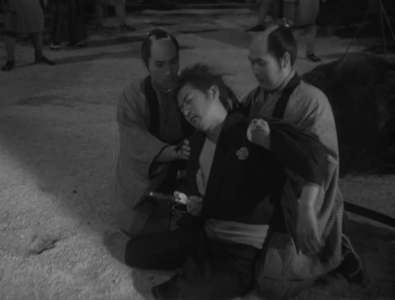
At the end of the film, however, the ronin has finally regained entry into the privileged space of the Yurugi clan… by committing seppuku in the courtyard of the inn at Seki. In this case, the now-dead ronin had brought with him, not a toy, but the prized katana intended as a wedding gift for the princess’ bridegroom, as well as a kind of last testament, in which he explains the theft of the weapon and pleads (as it turns out, successfully) for the life of Sankichi, his son. It’s only in death that Yosaku transcends – or ever could transcend – his outcast status.4
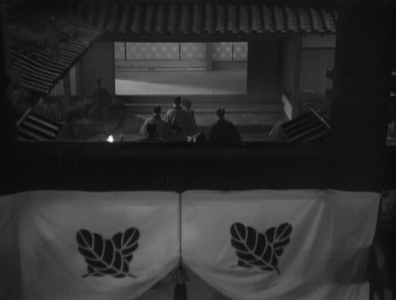
A recurring visual motif throughout the film is a banner representing what I assume to be the Yurugi clan’s crest. This mon (heraldic symbol) appears significantly at certain dramatic moments throughout the film, such as when Sankichi is captured and brought before old Kotayu to answer for the disappearance of the katana. The crest appears again at the very end of the film, also in a crane shot, when the princess’ procession leaves the castle to resume its journey to Edo. And unless I am mistaken, the leaves depicted in the crest represent those of the popular Paulownia tree (also known as the “princess tree” or “empress tree”).
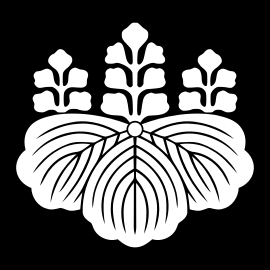
This fact is significant because the same distinctively-shaped leaves are used in the present day as a symbol representing the government of Japan, specifically the office of the prime minister (see image). The direction of the leaves is different in the two images – on the banner in the film, the leaves are shown facing upward, and in the official government image, the leaves face downward – but I believe the type of leaves depicted are the same in both. Did Uchida deliberately create a heraldic symbol that would suggest for the viewer a correlation between this harsh, morally rigid feudal clan and the contemporary Japanese state? If so, the image cleverly suggests a connection between the ancient era and the modern one.
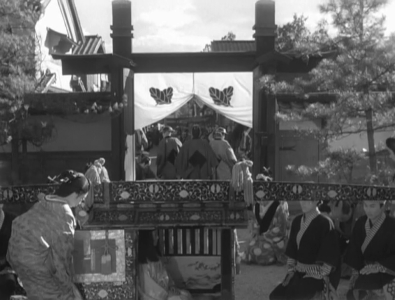
One of the most powerful symbols of the film is the palanquin, which, as I’ve already maintained, paradoxically represents both class privilege and entrapment. The film’s prologue ends with Shigeno (now called Shigenoi) being carried away from the castle (and from her newborn child) in a palanquin. In the middle of the movie, the headstrong princess steps out of her palanquin because the child wants out of a loveless, arranged marriage. And at the very end, the same princess, rebellious no longer, docilely climbs into the same palanquin to resume her journey to Edo.
Of Uchida’s classic performing arts tetralogy, The Horse Boy was the only one not filmed in color or in the widescreen process, the latter innovation being adopted for the first time in Japan in 1957, the year this film was released.5 (The initial installment of Uchida’s Sword in the Moonlight (Daibosatsu tōge) trilogy, released in July of that same year, would be the director’s first work in widescreen and color.) With the possible exception of A Bloody Spear at Mt. Fuji, The Horse Boy is also the most realistic and least stylized of the movies that were made in what I call Uchida’s “classical” style, a visual strategy that involves a “cool,” detached approach to period material.
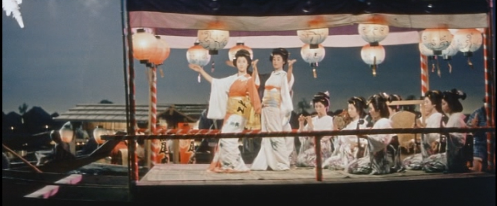
However, though The Horse Boy is a very dramatic and moving film, I believe that, for Uchida’s classical style fully to work, both color and widescreen are required. The cumulative impact of both Chikamatsu’s Love in Osaka (1959) and (especially) Hero of the Red-Light District (1960) is much greater than that of this movie, precisely because of the ironic distance between the dazzling visual beauty of those later films and the moral ugliness their narratives expose and critique.
If there is much greater visual opulence on display in the later performing arts films, there is also a greater sense of entrapment. For example, in The Mad Fox (1962), unlike in The Horse Boy, the countryside is not depicted as a liberating environment, but as a prison within which the insane hero, Yasuna, is trapped by his delusions. Yasuna’s ultimate destiny is thus not freedom, but extinction, and in the final shot only the butterflies are left alive. The progression over the course of the four films is one from (relative) realism to stylization, from the realm of life to the kingdom of death.
As already mentioned, Yamada Isuzu had already worked with Uchida as a teenager on The Revenge Champion (1931), but to this reunion of director and actress, she brought vastly greater artistic experience and maturity. I consider this film to be a counterpoint to and complement of her impressive work in Kurosawa Akira’s Throne of Blood from the same year. Just as her performance in the Kurosawa work incorporated elements from Noh to achieve a highly stylized portrait of evil, this performance uses a different kind of stylization to evoke the suffering of a woman who has somehow become an outcast within a highly codified world in which she must still, nonetheless, bear heavy responsibilities.
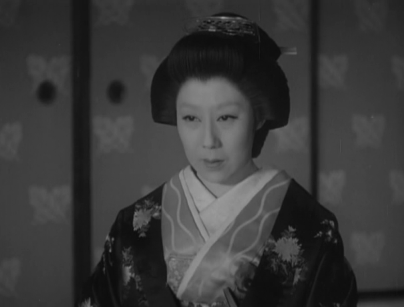
According to the rigid rules by which she lives, she has to serve as the surrogate parent of a child with whom she shares little if any biological kinship – the princess – and to reject her own flesh and blood, Sankichi, and this fact gives her great sorrow. There’s a moment in which she simply stares at the boy while he eats, ravenously and with terrible manners, and her look of overwhelming love, distaste and pity is remarkable.6 Unlike the play, Yamada’s character is not the central one in the film’s narrative, but she dominates every scene in which she appears, and she somehow doesn’t let the fact of being somewhat older (at forty) than Shigenoi’s presumed age destroy the credibility of her performance.
In the Japanese press, Sano Shūji’s performance as Yosaku was the one most highly lauded. According to Fujita, when the film was released, “Sano’s acting was praised as breaking new ground,” and one of the reviews was titled, “A good portrayal of feudal society: Sano’s excellent performance in Abarenbō kaidō.”7 The critics’ effusive approval may have been partly due to the fact that, as mentioned before, this was Sano’s first period role.
Whatever the reason, Uchida brings out aspects of the actor’s personality I’d never seen in his other roles. Even in Gosho Heinosuke’s An Inn at Osaka (Osaka no yado, 1954), one of his very best movies, Sano sometimes comes off as annoyingly diffident and remote. As Yosaku, though, he’s charmingly casual in the early scenes, and in the later ones, particularly the confrontation with the greedy stable master described above, he conveys remarkable passion. Among films featuring the actor that I’ve seen, only his performance in Ozu’s classic There Was a Father (Chichi Ariki, 1942) is comparably intense.
This movie has perhaps more common elements with Mizoguchi’s films than any other Uchida work. The presence of the actors Yamada Isuzu and Shindō Eitarō – the latter appeared, usually as the villain, in about a dozen Mizoguchi films, from the 1930s on – is one such connection. The strong thematic focus on the oppression and suffering of women (though within the context of “mother film” conventions) is another. In addition, stylistically the film feels more like the work of the auteur of Ugetsu and Sansho the Bailiff than other Uchida movies do.
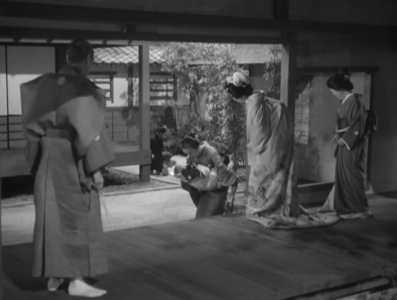
This is particularly true of the scene early in the film in which the baby Yonosuke is taken away from Shigenoi, as the accompanying image indicates. The use of an unbroken medium long shot to depict a scene of great emotional intensity is very typical of Uchida’s great contemporary. (He and Mizoguchi were born within weeks of each other in 1898.) So is the position of the figure of Shigenoi with her back to the camera, so that the expression on her face can’t be fully seen, as well as the precise placement of the figures of the parents on either side of her, and the position of the old serving woman, who stands in the courtyard holding the child at a level slightly below that of the others, befitting her social status.8

Yet the scene ends with a surprising flourish that is characteristically Uchida’s. After the infant is taken away, Shigenoi and her parents begin to exit by moving off to the left side of the frame. But the camera not only follows Shigenoi, but tracks in to a medium close shot of her face, revealing her quiet anguish.
We’ve already noted the odd fact that this movie does not appear in Kinema Junpo’s list of the Top 30 films released in 1957. This is mere speculation of course, but as it was Mizoguchi who in 1954 launched the Chikamatsu adaptation “mini-boom” with his A Story from Chikamatsu, the critics may have felt (wrongly) that Uchida’s movie was only a pale imitation of Mizoguchi’s masterpiece from three years before. In fact, the eight films Uchida released in the 1956-1958 period (of which this movie, of course, was one) appear to have been much less acclaimed than his hit comeback film from 1955, A Bloody Spear at Mt. Fuji.
The distinguished critic Iwasaki Akira in a passage9 about Uchida from one of his books, though he doesn’t mention The Horse Boy by name, was very critical of the films of this period, calling them (using a baseball metaphor) “weak hits,” and preferring Twilight Saloon (Tasogare sakaba, 1955) to all of them. The gist of Iwasaki’s argument was that Uchida had become much too eager to take on jobs assigned by his studio, Toei, rather than pursue personal projects – though as we’ve shown, such was definitely not the case with The Horse Boy.
In any case, we’ve every reason to assume that Iwasaki’s fellow critics shared his belief that Uchida was stuck in some kind of creative slump during this three-year period. After all, The Eleventh Hour (1957) would be the only film of those years to appear in the Kinema Junpo annual “Best Ten” film list, ranked at number seven for its year. It wouldn’t be until the late 1950s to early 1960s period, with the release of two later films in the performing arts tetralogy – Chikamatsu’s Love in Osaka (1959) and Hero of the Red-Light District (1960) – that Uchida would begin to overcome this negative perception.
This first of four adaptations by Uchida of classic Japanese dramas serves as a strong beginning for his fascinating exploration of Japan’s feudal past via its theatrical traditions; though the three later films in the series are all superior as cinema, this work, with its superbly-controlled style and excellent performances, should not be overlooked.
Fujita Nahiko’s article: “Adaptation of traditional performing arts in postwar Japan: Focusing on Uchida Tomu’s ‘Abarenbō Kaidō,’” 2021 (“Sengonihon ni okeru dentō geinō no adaputēshon — Uchidatomu no “abarenbō kaidō” o chūshin ni”) [Downloadable PDF file, in Japanese]
Martin Dowsing’s review
Senses of Cinema review [Alexander Jacoby] (“a small masterpiece… again Uchida’s target is the inflexible class system, inflected through a study of the disintegration of a family.”)
Tokyo FILMeX 2004 retrospective program notes
Museum of Modern Art (MOMA) 2016 Uchida Retrospective program notes